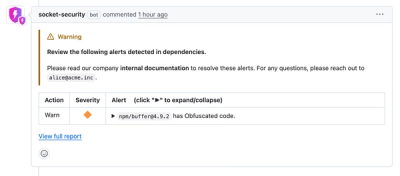
Security News
Crates.io Users Targeted by Phishing Emails
The Rust Security Response WG is warning of phishing emails from rustfoundation.dev targeting crates.io users.
stream-to-array
Advanced tools
The stream-to-array npm package is a utility that allows you to collect all the data from a stream into an array. This can be particularly useful when you need to process the entire content of a stream at once, rather than handling it piece by piece.
Convert Stream to Array
This feature allows you to convert a readable stream into an array. The example demonstrates creating a readable stream, pushing data into it, and then converting the stream into an array using the stream-to-array package.
const streamToArray = require('stream-to-array');
const { Readable } = require('stream');
const readable = new Readable({
read() {}
});
readable.push('data1');
readable.push('data2');
readable.push(null);
streamToArray(readable, (err, arr) => {
if (err) throw err;
console.log(arr); // ['data1', 'data2']
});The concat-stream package is similar to stream-to-array in that it collects all the data from a stream. However, instead of converting the stream to an array, it concatenates the data into a single Buffer, string, or array, depending on the input type. This can be useful if you need the entire content as a single entity rather than an array of chunks.
The bl (Buffer List) package is another alternative that collects data from a stream into a single Buffer object. It provides more advanced features for handling binary data and can be more efficient for certain use cases compared to stream-to-array.
The stream-buffers package provides a way to collect data from a stream into a buffer. It offers both writable and readable stream buffers, making it versatile for various use cases where you need to handle stream data as buffers.
Concatenate a readable stream's data into a single array.
You may also be interested in:
var toArray = require('stream-to-array')
Returns all the data objects in an array. This is useful for streams in object mode if you want to just use an array.
var stream = new Stream.Readable()
toArray(stream, function (err, arr) {
assert.ok(Array.isArray(arr))
})
If stream is not defined, it is assumed that this is a stream.
var stream = new Stream.Readable()
stream.toArray = toArray
stream.toArray(function (err, arr) {
})
If callback is not defined, then it returns a promise.
toArray(stream)
.then(function (parts) {
})
If you want to return a buffer, just use Buffer.concat(arr)
toArray(stream)
.then(function (parts) {
var buffers = []
for (var i = 0, l = parts.length; i < l ; ++i) {
var part = parts[i]
buffers.push((part instanceof Buffer) ? part : new Buffer(part))
}
return Buffer.concat(buffers)
})
FAQs
Concatenate a readable stream's data into a single array
The npm package stream-to-array receives a total of 1,776,949 weekly downloads. As such, stream-to-array popularity was classified as popular.
We found that stream-to-array demonstrated a not healthy version release cadence and project activity because the last version was released a year ago. It has 2 open source maintainers collaborating on the project.
Did you know?

Socket for GitHub automatically highlights issues in each pull request and monitors the health of all your open source dependencies. Discover the contents of your packages and block harmful activity before you install or update your dependencies.

Security News
The Rust Security Response WG is warning of phishing emails from rustfoundation.dev targeting crates.io users.

Product
Socket now lets you customize pull request alert headers, helping security teams share clear guidance right in PRs to speed reviews and reduce back-and-forth.

Product
Socket's Rust support is moving to Beta: all users can scan Cargo projects and generate SBOMs, including Cargo.toml-only crates, with Rust-aware supply chain checks.